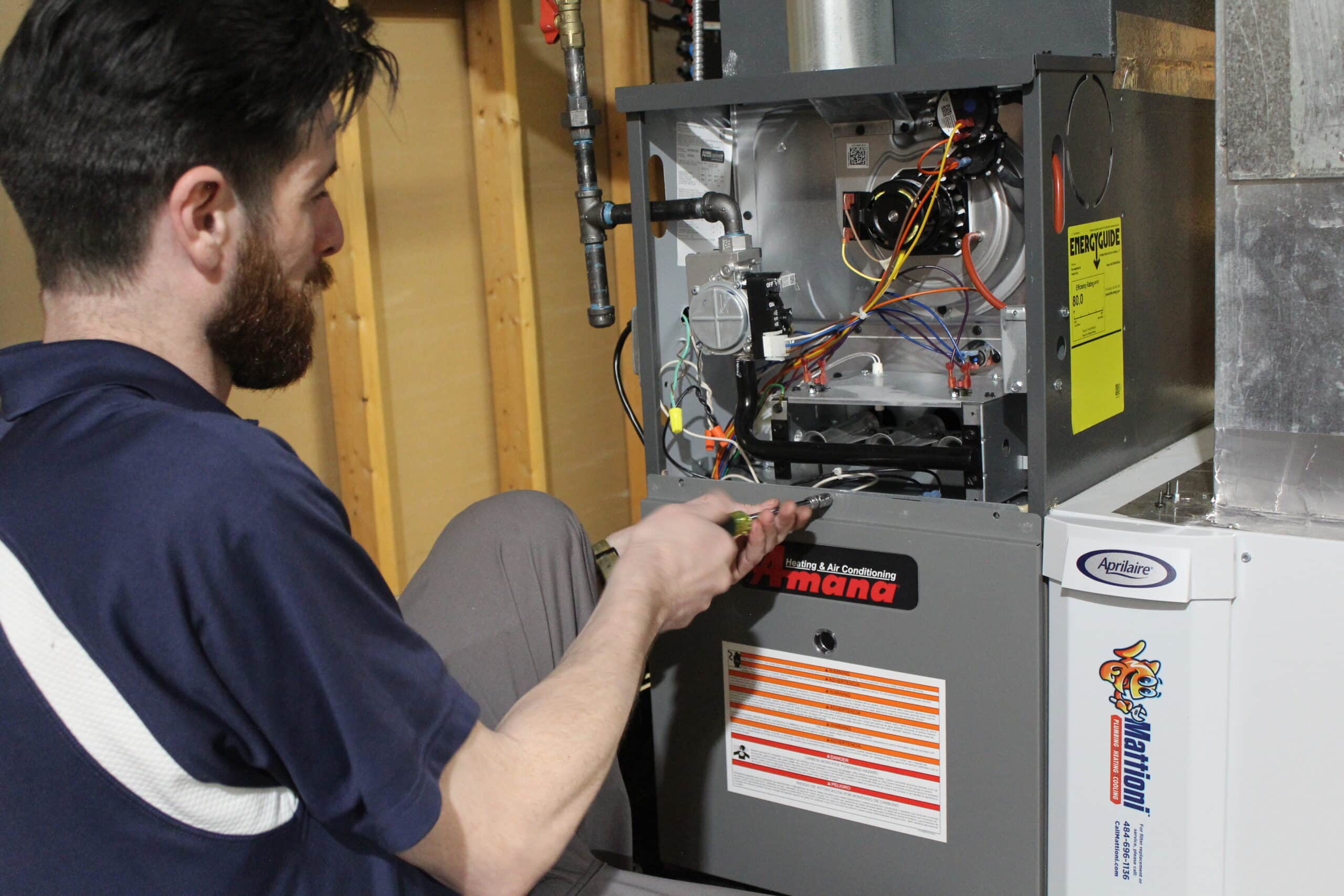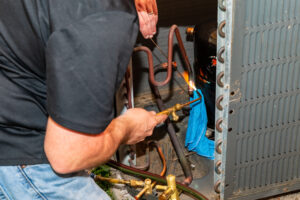How Much Does the Brand of the Equipment Matter for HVAC Installations?

Read Time: 6 mins. |
When it comes to replacing your HVAC equipment, how important is choosing a brand? There may be another, more significant question you should be asking yourself.
Last Revised: April 8, 2024
Home heating and cooling systems are constantly improving in performance and efficiency. Heightened energy regulations have spurred HVAC manufacturers to make as many efficiency upgrades as possible to their existing systems.
So, if you thought that the brand of heating or cooling system that you choose to install in your home matters, you’d be right. However, the question you ought to be asking isn’t what’s the best brand? But rather, how much does brand matter?
When it comes down to it, there’s far more that goes into your new air conditioner or furnace’s performance than simply the manufacturer. In fact, your new system’s performance level is much more dependent on the quality of its installation than its brand.
An experienced and thoughtful HVAC professional will take the extra steps to ensure the following considerations are properly addressed during an installation:
- Refrigerant Line Updates & Brazing
- Ductwork Sizing Updates
- Appropriate Electrical Sizing
These areas are often overlooked by inexperienced or unprofessional HVAC installers, which can lead to all sorts of consequences including a decreased lifespan.
Does the brand of your HVAC equipment matter? A little. Warranties vary from brand to brand, which can prevent or cause headaches in the future.
Is the quality of the installation more important than the brand? Yes. A proper installation can set your system up for optimal performance, efficiency and longevity. While a poor installation can lead to all sorts of problems in these areas.
So how do you know if the HVAC company you’re speaking with will deliver a quality installation? In this article, we’ll cover all you need to know about the importance of a quality HVAC installation, the green flags to look for in an installation company, as well as just how much you should factor a system’s brand into your decision-making process.
Understanding the Impact of Brand vs. Installation Quality on HVAC Performance
Yes, not all manufacturers of heating and cooling equipment are created 100% equal. Different brands focus on incorporating the latest and greatest technologies to improve how long their systems can last, and some companies stand behind their systems with stronger warranties. So, when evaluating different heating and cooling manufacturers, the longevity of the system is very much in play.
However, when it comes to the way that different heating and cooling brands perform, there isn’t a big difference across the board. Each different brand contains the same key components which leads to very similar performance between producers.
All comparable systems with the same specifications will heat or cool your house at the same performance and efficiency rates, regardless of the brand. The biggest gap among heating and cooling brands is between what we call builder-grade (the system that was first installed into a home by the construction company) and all others.
Builder-grade systems are produced specially for these construction companies at a lower cost and quality, and most noticeably they lack system safety features that minimize problems when they happen. Therefore, they typically have a shorter lifespan than your average replacement option. Yet even these systems will have the same efficiency and quality of heating or cooling while in operation.
What has a greater impact on the performance and efficiency of your new system is how well it’s installed by your HVAC professional. After all, this isn’t your typical appliance that’s simply taken out of the box and plugged in. HVAC systems have several technical considerations that need to be made when being installed.
What Separates a Good HVAC Installation from a Bad One?
Like most contractor work, when a new heating or cooling system is being installed there’s the possibility of corner cutting. What’s frightening is that you might never know any difference in the matter, but, if a corner is cut, your system won’t run as effectively as it’s capable of from day one.
For example, it’s possible for an HVAC installer to simply remove the old unit, connect the new one to the existing utilities without making any considerations about modifications needed, and call it “good enough.” Yes, the system will work, however its capabilities will be hamstrung immediately. And considering the investment size of these projects, this isn’t something anybody wants.
So, what considerations go into a high-quality installation?
1. Updating and Brazing Refrigerant Lines
New air conditioners and heat pumps must be connected to the copper refrigerant lines that run between the indoor and outdoor coils. Doing so involves a process called brazing, which is similar to soldering, but is unique in two ways:
- Brazing occurs at a higher temperature than soldering to strengthen the joint.
- Brazing incorporates nitrogen to keep the joint surface clean and prevent oxidation on the inside of the tubing where the refrigerant runs

Overall, brazing produces a stronger, cleaner joint which is why it’s considered the only tried and true method to properly fit refrigerant lines together. Yet some HVAC installers still use the soldering method, which makes the line susceptible to leaks and leaves copper oxide, which looks like small black flakes, trapped in the lines.
These black flakes impede and potentially block the flow of refrigerant as the copper lines narrow and approach each coil and metering device, which significantly reduces the output of cool air from the system. In other words, copper oxide hurts both performance and efficiency, not to mention it’ll wear the system out sooner. Brazing with nitrogen prevents this situation from happening.
Additionally, if you’re upgrading your cooling system then you’re probably switching to a newer, more efficient refrigerant that could require a different line set size. It’s possible that an installer can haphazardly connect the new system (and new refrigerant) to your old, narrower lines and call it a day. This is a prime example of what a poor installation can look like.
2. Ductwork Sizing Updates
Your heating and cooling systems should also be hooked up to appropriately sized ductwork to promote proper airflow. A replacement unit requires this to be addressed, otherwise the airflow may be constrained, which weakens the performance and efficiency of the whole system.
The most important area of ductwork to consider is that nearest to the furnace, or air handler. A quality installation oftentimes includes adding a plenum, a wide central duct for air to travel through on its way to the rest of the home, and a return drop, another wide central duct for air to travel through as it returns to the heating or cooling unit.
Creating quality ductwork infrastructure surrounding your heating and cooling systems might sound like a bonus, but it’s a standard step in many installations. Skipping this step can lead, once again, to hindered performance, efficiency, and system health.
3. Appropriate Electrical Sizing
Another consideration that can have big consequences if neglected during the installation process, particularly with air conditioners, is the electrical connections.
Your new cooling system might have different electrical needs, so appropriately matching the wiring with the breaker size is an area that must be addressed. Providing sound electric connections is going to keep your new system safe, and failing to update them can potentially cause a fire hazard.
You’ll notice that all three of these considerations boil down to one thing: a good installation extends beyond just the new piece of equipment. The utility connections within the system are what empower your new air conditioner or furnace to run smoothly. They’re also what’ll keep you comfortable and save you money on utilities and repairs.
4. Additional & Important HVAC Installation Considerations
A thoughtful HVAC installer will also ensure that the following areas of your new HVAC system have been properly addressed:
- Equipment matching
- Refrigerant evacuation
- Refrigerant levels
- Filter sizing
- Condensate safety
- Airflow
- Vent sizing & termination
These installation steps could potentially be left out of the process; however they should at least be examined to determine if any one area requires more attention. If you have questions about any of these installation steps, don’t hesitate to ask your HVAC professional.
How to Tell When You’ll Get a Quality HVAC Installation
All of this goes to show why the quality of installation you’ll be receiving should be a key factor in your decision-making process. There are a few ways that you can be sure that you’re moving forward with someone who gives the time and consideration needed to all their customer’s HVAC installations.
First, be sure to choose a service provider that has positive reviews from previous customers. There’s nothing wrong with asking an HVAC professional for a testimonial or pictures from past installations.
Second, pay attention to how thorough your HVAC professional is in explaining the details of the job. If you are given a complete explanation of the installation and get understandable answers to your questions, it’s another sign that you’re getting a high-quality service provider.
Last, make sure to ask about the details of warranties provided after the installation. Most equipment should come with some type of warranty, but if the installation company provides further warranties, it’s a sign that they stand by their work.
Schedule an HVAC Consultation
If you haven’t already, a good place to continue your heating or cooling replacement search is by speaking with an HVAC professional about your priorities and how best to achieve them.

Be sure to ask any questions you might still have about the significance of the brand of equipment, and how to make sure you’re getting a quality installation. Being mindful of the professionalism and courtesy of those within your installation company can help you be confident that your new system will be properly hooked up and set up for optimal performance.
Things like warranties and examples of previous work are green flags that you’ve found a quality service provider.
We’re committed to providing a transparent HVAC replacement process for all our customers. When you’re ready, call us at 610-400-8510 to get your questions answered by one of our friendly HVAC professionals, or schedule a consultation online.





